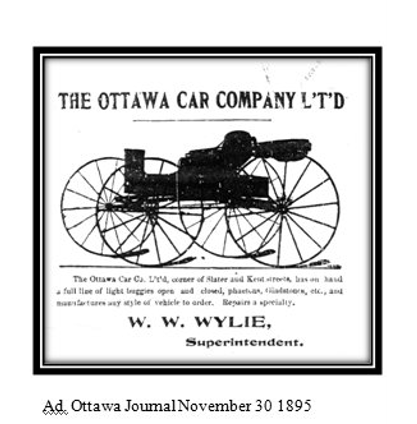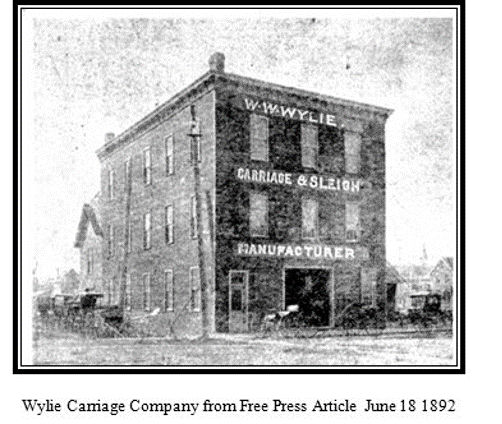
One of the most expert, successful and widely known car and carriage builders in Canada
WILLIAM WASHINGTON WYLIE Section 40, Lot 90 W Ctr (Bus)
William Washington Wylie was born to Scottish parents on May 17, 1860 in Ovalle, Chile. As a young man, he was sent back to Scotland for his education, after which he was apprenticed to the carriage trade in Paisley.
He went on to work for three years in Liverpool, England building street cars, before emigrating to Montreal at the age of 22, where he found employment as a railway coach builder for the Grand Trunk Corporation for two years.
The Grand Trunk Corporation is the subsidiary holding company for the Canadian National Railway's properties in the United States. The Canadian National Railway Company (French: Compagnie des Chemins de fer nationaux du Canada) (reporting mark CN) is a Canadian Class I freight railway headquartered in Montreal, Quebec, which serves Canada and the Midwestern and Southern United States. CN is Canada's largest railway, in terms of both revenue and the physical size of its rail network, spanning Canada from the Atlantic coast in Nova Scotia to the Pacific coast in British Columbia across approximately 20,400 route miles (32,831 km) of track. In the late 20th century, CN gained extensive capacity in the United States by taking over such railroads as the Illinois Central.
 In the mid 1880s, Wylie travelled to Ottawa, where he began working in partnership with Richard Shore, who owned a small carriage shop on Queen Street, behind Davidson & Thackeray’s mill. Shore & Co., after the fires of 1890 and 1891, moved to the corner of Slater and Kent Streets, where they quickly built a three-story building to house the operation.
In the mid 1880s, Wylie travelled to Ottawa, where he began working in partnership with Richard Shore, who owned a small carriage shop on Queen Street, behind Davidson & Thackeray’s mill. Shore & Co., after the fires of 1890 and 1891, moved to the corner of Slater and Kent Streets, where they quickly built a three-story building to house the operation.
The second fire may have proven too much for Shore, who retired not long after, leaving Wylie to run the business on his own. He continued to build carriages, busses and sleighs, and soon started to build cars for the Ottawa Electric Railway Company, founded that same year.
Preceding the use of electric streetcars, Ottawa's first public transportation system was the operation of a horsecar system. Tramway service began in July 1870 under the Ottawa City Passenger Railway Company, which was incorporated on August 15, 1866. The O.C.P.R. was financed largely by the estate of Thomas McKay (an early founder of Ottawa). In 1868, Thomas Reynolds bought control of the company intending to use it to transport lumber at night from the Chaudiere mills to McTaggart Street, the terminal of the St. Lawrence and Ottawa Railway. In 1871, Reynolds sold his streetcar company interest to Thomas Keifer.
The horse-drawn streetcars travelled back and forth from New Edinburgh to the Chaudière Bridge. The trams for passengers and freight had a line extending from Rideau Falls in New Edinburgh, to Sussex, Sparks, Wellington, Duke (in Lebreton Flats) and the Suspension Bridge.
The service provided sleighs in the winter and had 273,000 passengers in its first year of operation. In 1891, it had four miles (6.4 km) of track, 25 horses and 15 employees. The Ottawa City Passenger Railway Company had tram cars holding 20 passengers which were made of wood with bench seats. The company applied to the city to convert to electricity but was refused, and later it proposed a merger of two companies.A new company, Ottawa Electric Railway Company, would appear on the scene in the early 1890s and would later dominate public transportation in Ottawa.
Initially the OERC brought in several dozen streetcars in from St. Catherines; but Wylie’s work proved to be of equal quality, and having the streetcars produced locally saved the OERC a great deal of money. By mid-1891, Wylie had been approached by several stockholders of the OERC, proposing that he expand the company to create a new branch dedicated entirely to producing streetcars.
Wylie did just that in September, starting the Ottawa Car Company (Limited), where he served as VicePresident and managing director. The company’s first board boasted several notable Ottawa names (many of whom are also buried at Beechwood), including Thomas Ahearn and Warren Soper. By 1893, the OERC bought the Ottawa Car Company, keeping Wylie on in the same position. The business continued to grow – fifty to sixty streetcars were being made each year and were shipped to cities across Canada.
Wylie became “one of the most expert, successful and widely known car and carriage builders in Canada.”
The Ottawa Car Company was a builder of streetcars for the Canadian market and was founded in Ottawa, Ontario, in 1891[1] as an outgrowth of the carriage building operations of William W. Wylie. Its plant was located at Kent and Slater Streets (south side of Slater between Kent and Lyon Streets - now site of Constitution Square) , a short distance from Parliament Hill. The company was a subsidiary of Ottawa Electric Railway, in turn controlled by Ahearn & Soper. It was renamed Ottawa Car Manufacturing Company in 1917 and again as Ottawa Car and Aircraft Limited in 1937.
The Ahearn family retained control of the company until 1948 when they sold Ottawa Car & Aircraft Corporation (renamed during World War II) to the Mailman Corporation. The new owners never carried on the business and ceased operations as streetcars were being abandoned by cities across North America. The city of Ottawa abandoned its own streetcar network in 1959. The company produced a total of about 1700 vehicles. On 19 August 1994 Canada Post issued 88¢ stamps featuring Ottawa Car Company Streetcar, 1894, Saint John Railway Co. Car #40
By 1904, the company had grown in leaps and bounds – from the original 35-man staff of Shore & Co. in the early 1890s, the Ottawa Car Company employed 185 men, and was “one of the most progressive and flourishing industrial establishments of the capital.” And from the three-story building on the corner of Slater and Kent, the company had expanded to cover fully two-thirds of the block, occupying almost nine city lots (then broken down in parcels of 66’x99’).
In 1911, Wylie retired from building his streetcars, and built a house at 190 Carling Ave (now Glebe Ave). He died in Ottawa on June 24, 1921.

